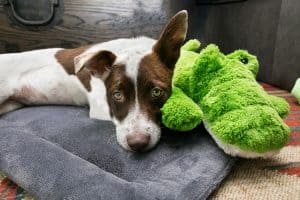
Keeping Dogs & Cats Safe During Fireworks, Thunderstorms, and Other Loud Noises
Fireworks and thunderstorms are the most common triggering events or dogs and cats, and the biggest reason pets go missing. In fact, the 4th of July holiday, celebrated with massive fireworks shows, is the #1 cause for runaway pets in the U.S. Because your pet’s safety is our #1 goal, we’ve put together a crucial list for how to keep your pet safe during fireworks and thunderstorms. Keep in mind that all dogs and cats are different, so different approaches may work differently for each animal.
For best results, start working with your pet ahead of time to help desensitize and countercondition them for these specific events and loud noises. Desensitizing helps your pet to become less sensitive to the sounds by playing them often, in conjunction with counterconditioning, which offers a reward to your pet while the experience the trigger.
- Start with a playlist search on your favorite music streaming service for thunderstorm or firework noises. This one on Spotify from Calmsound has a variety of sounds to choose from and is made specifically for desensitization and counterconditioning pets.
- Play the sound you are choosing to desensitize your pet with at a very low volume in the background. During this time, to countercondition, give your dog or cat a KONG filled with their favorite stuffing (see “KONG or Kitty KONG” bullet below for recommendations). Be sure your cat has a Kitty KONG, which is size and strength-appropriate just for cats.
- Over time, gently increase the sound volume so it is noticeable. For instance, play this playlist 3-4 times per week, starting on day one with very low volume, and increase the volume each day by a little. Dogs and cats have extraordinary hearing, so you don’t have to increase to an extremely loud level. If the noise starts to cause stress in your pet, stop the practice for the day. Keep the volume at a lower level the next time you practice until they become comfortable, then you can increase the volume minimally. Go at your pet’s own pace, and never scold your pet during desensitization and counterconditioning practices.
- For a great step-by-step guide on how to countercondition, read our article called How To Make Trimming Your Dog’s Toenails Easier. You can substitute almost any item or sound your pet is fearful of for the nail trimmers mentioned in this blog.
Prepare your home 
- Keep Pets Inside & Away From Doors. Make sure all doors and pet-level windows are closed tightly. If you plan on going in and out of doors during a firework show, plan to keep your pet in a safe and secure place inside your home. If you take your dog outside to potty, even in a fenced yard, keep them on a leash. You can never be too careful with a scared pup. Baby gates can help reinforce the safety factor of doors you might be going in and out of. However, we recommend planning for your activity level, and try not to use doors that pets have access to often during the event.
- Drown Out Noises. A fan can help muffle the sound of fireworks. You can also play music from a playlist on your favorite music streaming app. Just search for “dog calming music” or “cat calming music” and a pre-made list should pop up. Here is one on Spotify from Pet Music Academy.
- Cover Windows. To help reduce your pet’s visual triggers, pull the blinds down and shut your curtains. If you do not have window coverings, you can purchase a roll of reflective bubble insulation, which can be cut and fit to the windows you need to cover. This will completely block out your windows without having to install a permanent fixture.
- ID Tags, Microchips & GPS Trackers. Make sure the correct information is listed for your pet on their ID tags and microchip. If a dog is turned in to a shelter, they can easily scan your pet’s microchip and give you a call to let you know they have your pet. Similarly, if a citizen picks up your pet, they can easily read your pet’s ID tag and reach you before having to take your pet to the shelter. GPS trackers have become popular over the last couple of years, and you can find relatively inexpensive options online from several brands. Your pet wears the GPS tracker on their collar, and you download the tracking app on your smartphone so you can always see where your pet is on the app’s map. These work great for finding your missing pet on your own without the stress of waiting for them to turn up at a shelter. Check out this video from 7News Australia about using GPS technology to track your pets.
Tools, products, and tips for calming your pet
- Calming Products Ingredients found in calming products work uniquely in different species, as well for individual dogs and cats. We always recommend speaking to your veterinarian so they can assess the right type of product for your pet, as well as trying the product out before the anticipated triggering event. For over-the-counter calming products, some ingredients that are used for calming are:
- Valerian Root – In Latin, “valerian” comes from the word “valere”, which means to be well. If your dog doesn’t respond well to CBD, valerian root might be more effective. It is believed that increasing GABA (gamma-aminobutyric acid) in the brain can create a calming, sedative, and relaxed state in dogs. Valerian root can be found in herb form, as well as in a variety of dog-specific formulated calming treats & tinctures, as well as essential oils. Not all essential oils are safe to use for pets. Please consult a veterinarian before use. While valerian root is safe for cats, its effects typically aren’t as calming as with dogs.
- L-Tryptophan – Most commonly known as the reason we sleep after we humans consuming turkey, L-Tryptophan is an amino acid used in human and animal bodies to produce the neurotransmitter serotonin, and the hormone melatonin. Melatonin is best known for its sleep-enhancing properties, while serotonin produces anti-anxiety and calming effects in the body’s neurological pathways.
- Lavender & Chamomile Essential Oils – One study done by Canine Behaviour Center, School of Psychology, at Queen’s University Belfast in Northern Ireland, shows both lavender and chamomile essential oils have been reported to produce a calming effect on dogs when diffused. Both oils increased rest & sleep, and reduced barking in dogs who were housed in animal shelters. Contrarily, the use of rosemary and peppermint oils increased standing, moving, and vocalization. For safety, please consult with your veterinarian before using essential oils with your pets. Oils deemed safe for diffusion with pets should be highly diluted. Many essential oils can be toxic to cats. Here is a list of essential oils which are toxic to pets (dogs & cats) from Texas A&M School of Veterinary Medicine & Biosciences.
- Calming Shirts—Calming shirts work like a hug, much like swaddling an infant or the use of a weighted blanket. These types of shirts or wraps distribute equal pressure around the dog or cat’s body, which releases endorphins to calm your pet. These shirts should be applied before the anticipated triggering event. They can be used in conjunction with other products, like calming treats or a KONG.

- KONG or Kitty KONG— Fill your pet’s KONG with their absolute favorite treats or foods. You might have to do a little research beforehand to find the foods that your pet absolutely adores.
- For dogs, this might be: hot pieces, small pieces of chicken, beef, or fish, dehydrated or baked fish skins, cheese, goat milk, freeze-dried meats, wet or raw dog foods, etc.
- For cats this might be freeze-dried treats like: minnows, fish bites, chicken hearts or livers, or their favorite wet or raw foods.
- Mix your pet’s favorite treat with wet food, canned pumpkin, peanut butter or mashed sweet potatoes, stuff the mixture in a KONG and freeze. It’s best to have a couple of these ready to go ahead of time in case the fireworks or storm last awhile. We recommend giving calming treats ahead of the KONG so they have time to take effect before the triggering event.
- Veterinarian Help—If you’ve tried everything under the sun and nothing helps to soothe your pet, or if you have questions about the safety or efficacy of any of these products or suggestions for your pet, please consult your veterinarian. Your pet might need a prescription medication to help calm them in triggering events.
Teamwork makes the dream work
If you’re having trouble with desensitization and counterconditioning, we recommend working with a trainer or behaviorist who can teach you how to help your dog or cat. All animals are not created equally, so it may take some time to figure out what works best for your pet and you. Make sure to talk with all members of your household when planning for triggering events, so everyone knows what to look out for and how to help your pet stay safe!
 from Laurel Lewis
from Laurel Lewis



